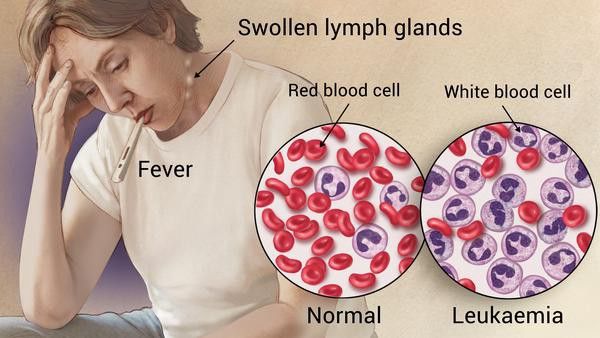
Cancer occurs when there is uncontrolled abnormal cell growth and development. It disturbs the normal life span of cells wherein they are formed, mature, carry out their intended function, die, and are replaced by new cells which are constantly regenerated in the body to maintain normal cellular function. Cancer represents the disturbance of this process. Leukaemia Cancer is cancer of the white blood cells.
The symptoms of leukaemia include:
- Breathlessness
- Having repeated infections over a short space of time
- Pale skin
- Tiredness
- In acute leukaemia Cancer, the condition progresses at a rapid and aggressive pace, and treatment needs to be administered immediately.
Bone marrow
Bone marrow is a spongy material that is found inside the bones, and it produces all of the blood cells. It also produces vital cells called stem cells that can create other specialised cells that carry out essential functions. These specialised cells are of three types:
- Red blood cells which carry oxygen around the body
- White blood cells which help fight infection
- Platelets which help stop bleeding
Acute leukaemia Cancer prevents the affected bone marrow from producing stem cells that mature into adult blood cells. Instead it releases numerous immature blood cells called blast cells. The immature white blood cells begin to rapidly disrupt the normal balance of cells in the blood, limiting the presence of red blood cells or platelet cells in the body. This can lead to tiredness and other symptoms of anaemia, and also increase risk of excessive bleeding. The patient also becomes more vulnerable to infection as the white blood cells are not properly formed and thus ineffective in fighting bacteria and viruses.
Types of acute leukaemia Cancer
There are two main types of white blood cells classified according to the type of white blood cells that are affected by cancer:
- Lymphocytes which are mostly used to fight viral infections
- Myeloid cells which fight bacterial infections defend the body against parasites and prevent the spread of tissue damage.
The two main types of acute leukaemia are:
- Acute lymphoblastic leukaemia, which is cancer of the lymphocytes
- Acute myeloid leukaemia, which is cancer of the myeloid cells
Acute myeloid leukaemia
It is more common in older people, especially when over 50 years of age, and more common in males than females, though it is not clear why. The causes of acute leukaemia are uncertain, but known risk factors include
Exposure to high levels of radiation
Exposure to benzene, a chemical that is used in manufacturing and is also found in cigarettes The lack of healthy blood cells in the blood supply causes most of the symptoms of acute leukaemia, which usually begin slowly before rapidly escalating in severity as the number of blast cells in the blood increases.
Outlook
The outlook for people with AML depends on the sub-type of AML, with some subtypes being more challenging to treat than others. The cure rate thus varies, and some sub-types have a 75 per cent cure rate, while others have a 20 per cent cure rate. The outlook also favours younger people as compared to older people. The treatment usually includes a combination of chemotherapy and radiation, or a bone marrow transplant in some cases.
Acute lymphoblastic leukaemia
ALL is the most common type of cancer found in children, though it is uncommon on an overall basis. Approximately one in every 2,000 children will develop ALL. The majority of cases develop in the age group of two to five year olds, and 85 per cent develop in children below the age of 15.
Outlook
The outlook for children with ALL is optimistic, as almost all of them will achieve a remission from their symptoms. 85 per cent of children will be completely cured, whereas only 40 per cent of adults will be completely cured.
Treatment
Treatment for AML involves two stages:
Induction: The aim of the initial stage of treatment is to kill the leukaemia cells in the bone marrow, restore the blood to proper working order and resolve any symptoms that may be present.
Consolidation: This stage aims to kill any remaining leukaemia cells that may be present in the central nervous system.
Treatment for ALL involves three stages:
- Induction
- Consolidation
- Maintenance, which involves taking regular doses of chemotherapy tablets to prevent the leukaemia returning. This seems to be the most effective stage.
Other treatments
- Radiotherapy
- Stem Cell Transplant
- Targeted therapies
New directions
The treatment of hematologic malignancies is rapidly changing, and primary therapy for leukaemia has advanced steadily over the past years. Biologic advances have led to a better understanding of drug resistance and the emergence of various targeted therapies, which have revolutionised the way in which leukaemia’s are treated. Some of these offer patients more treatment options with less toxicity.

 Click to WhatsApp
Click to WhatsApp +91-9899993637
+91-9899993637



